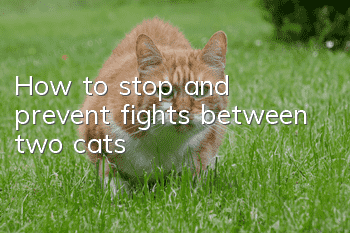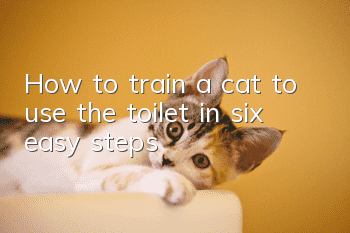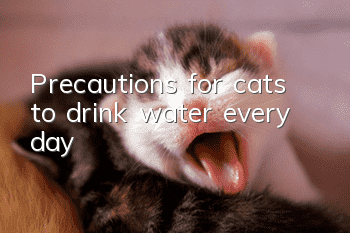How to stop and prevent fights between two cats?

Raising one cat is afraid of being lonely, and raising two cats is afraid of them fighting. This is a headache for many cat owners. So how should poop shovelers prevent this behavior and let them coexist peacefully? Let’s learn together below!
Why do cats fight?
Before we learn how to train cats to coexist peacefully, we need to understand why cats fight.
Fights between two domestic cats often stem from the cats' strong "territorial awareness." In other words, cats have a strong possessive desire for their own cages and bowls. Therefore, when it senses that other cats want to encroach on its territory, it will show aggressive behavior. Therefore, when cats fight, it is because they feel threatened by each other when they meet.
Therefore, if you put them in the same cage and force them to get along, or let them use the same litter box, this will only put more pressure on each other and make it impossible for them to become friends. The way to completely prevent them from fighting is to train them to eliminate their hostility towards each other when they meet, and gradually develop a good impression of each other.
So, how to train cats to eliminate their hostility towards each other when they meet? The training method is very simple and uses the familiar principle of "conditioned reflex". The conditioned reflex training plan prepared here for everyone contains three types of conditioned reflex training. Through triple conditioned reflex training, it is easy for two cats to learn to coexist peacefully.
The first conditioned reflex
The first level of conditioned reflex is to take advantage of the cat’s need for food. If you can make cats reflexively imagine the wonderful experience of eating when they see each other again, then they will naturally develop a good impression when they meet. The first level of conditioned reflex requires six major steps to complete the training, which is also the main part of our training. Let's look at it step by step.
STEP1
Let the cat have a desire for food first, so the cat cannot be allowed to eat food casually. It must be fed at a fixed period and the total amount of food given to it should be reduced by 20%-30%, so that it can have a higher desire for food. Of course, don’t let the cat go hungry. The remaining 20%-30% of food should be made up by giving snacks. By the way, cat treats are a key prop in training, and here is its first magical use.
STEP2
Let the two cats avoid each other and set their own activity areas at home. There must be a fence between the two cats to prevent them from interacting and fighting.Rack etc. The placement of the fence, the size of the cat's activity range, etc. need to be set and adjusted by you according to the situation at home.
STEP3
Feed your cat a specific way. When feeding each meal, the distance between the two dinner plates should ensure that the cats can see each other, but it will not cause a fight. Put food down at the same time, and put away food and bowls at the same time. In short, make sure that the cat can see and smell the other person when eating. Slowly, the cat will associate the other person with food.
STEP4
Gradually shorten the distance between the two dinner plates. Don't move too much each time. Five centimeters is enough. Each time you move it, you need to feed at that location for many days until you confirm that the two cats are not stressed at all when eating. No, only then can we close the distance by another five centimeters.
STEP5
If the cat is reluctant to eat after moving, or appears restless, restless, panting, growling, or even attacking, it means that the poop scooping operation is too hasty. Please return to the place where there was no problem before and train again.
STEP6
Keep the distance short enough that the two cats can almost touch each other and eat their food safely.
Second conditioned reflex
In the process of operating the above six steps, everyone can complete the second level of conditioned reflex training at the same time. When you are alone with one of the cats, you have to learn to ignore the cat's existence. Only when the two cats meet, you will treat the two cats better and pay more attention to them. This will make the cat associate the meeting with another cat with the owner's favor, completing the second level of conditioned reflex.
The third level of conditioned reflex
Finally, it’s the turn of the key prop - snacks. Please prepare treats for both cats. Whenever the two cats are near each other on the fence, sprinkle their favorite treats on both sides. This will make the cat have the desire to "expect to see the other party" because when the other party does not exist. Gradually make the cat believe that it can get delicious snacks when the other person appears. This is the third level of conditioned reflex.
The next step is observation. When you observe that the interaction between the two cats has stabilized, you can open the fence and let the two cats come into contact. Remember, you still need to maintain the previous practice at this time, and do not pay any special attention or food to any one of the cats. Only when two cats appear together at the same time, you will pay attention to both cats at the same time. Interaction, this kindInteractions include giving snacks and playing games.
Over time, under the powerful magic of the triple "conditioned reflex", the two cats will gradually "expect to see each other and get along with each other." Naturally there will be no fighting.
- What to do if you are scratched by a stray cat? It is best to get a rabies shot
- Why does a cat suddenly bite its owner?
- Why does a cat poop cat food?
- Why can't cats eat salt?
- Why are cats not clingy?
- What should I do if my hot cat sticks out its tongue all the time?
- What is pet freeze-drying? How to feed freeze-dried food to cats?
- How long is the life span of a civet cat?
- What kind of shower gel is best for cat bathing?
- The cat keeps rubbing here and there



